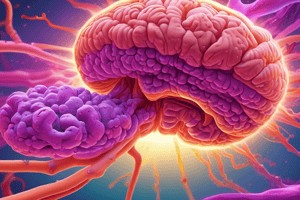Podcast
Questions and Answers
What anatomical structure of the pancreas is located between the head and the body?
What anatomical structure of the pancreas is located between the head and the body?
- Body
- Tail
- Neck (correct)
- Uncinate process
Which part of the pancreas is retroperitoneal, except for a specific section?
Which part of the pancreas is retroperitoneal, except for a specific section?
- Neck
- Body
- Tail (correct)
- Head
What structure regulates the secretion of pancreatic juices into the duodenum?
What structure regulates the secretion of pancreatic juices into the duodenum?
- Sphincter of Oddi (correct)
- Main pancreatic duct
- Major duodenal papilla
- Hepatopancreatic ampulla
Which part of the pancreas is the widest section located within the C-shaped curve of the duodenum?
Which part of the pancreas is the widest section located within the C-shaped curve of the duodenum?
Where does the main pancreatic duct unite with the common bile duct?
Where does the main pancreatic duct unite with the common bile duct?
What is the primary role of the acini in the pancreas?
What is the primary role of the acini in the pancreas?
Which hormone is primarily secreted by the alpha cells of the islets of Langerhans?
Which hormone is primarily secreted by the alpha cells of the islets of Langerhans?
Which of the following digestive enzymes is directly activated by enterokinase when chyme contacts the intestinal mucosa?
Which of the following digestive enzymes is directly activated by enterokinase when chyme contacts the intestinal mucosa?
What is the function of bicarbonate ions secreted by the pancreas?
What is the function of bicarbonate ions secreted by the pancreas?
Which types of nutrients does the pancreas help to digest?
Which types of nutrients does the pancreas help to digest?
What hormone is released in the gastrointestinal tract in response to food intake that triggers insulin secretion?
What hormone is released in the gastrointestinal tract in response to food intake that triggers insulin secretion?
How does insulin facilitate the uptake of glucose into cells?
How does insulin facilitate the uptake of glucose into cells?
What process does insulin stimulate in the liver to manage excess glucose?
What process does insulin stimulate in the liver to manage excess glucose?
Which of the following actions does insulin NOT perform?
Which of the following actions does insulin NOT perform?
What regulates the secretion of insulin?
What regulates the secretion of insulin?
What happens to glucose that is not immediately used by the body?
What happens to glucose that is not immediately used by the body?
Which hormone is secreted when blood glucose levels are low?
Which hormone is secreted when blood glucose levels are low?
What is the primary function of insulin?
What is the primary function of insulin?
Which of the following cells do not require insulin for glucose uptake?
Which of the following cells do not require insulin for glucose uptake?
What effect does glucagon have on triglycerides?
What effect does glucagon have on triglycerides?
How is glucagon production regulated?
How is glucagon production regulated?
Which process describes the conversion of glycogen back into glucose?
Which process describes the conversion of glycogen back into glucose?
What is the normal blood glucose concentration range that is tightly maintained?
What is the normal blood glucose concentration range that is tightly maintained?
What is the primary role of trypsin inhibitor in the pancreas?
What is the primary role of trypsin inhibitor in the pancreas?
Which ions are secreted mainly by the epithelial cells of the pancreatic ductules?
Which ions are secreted mainly by the epithelial cells of the pancreatic ductules?
What triggers the release of secretin from the duodenum?
What triggers the release of secretin from the duodenum?
What is the effect of cholecystokinin on the pancreas?
What is the effect of cholecystokinin on the pancreas?
How does bicarbonate ion secretion affect pancreatic venous blood?
How does bicarbonate ion secretion affect pancreatic venous blood?
What role does insulin play in blood glucose levels?
What role does insulin play in blood glucose levels?
What physiological condition stimulates the release of acetylcholine in the pancreas?
What physiological condition stimulates the release of acetylcholine in the pancreas?
The acinar cells produce digestive enzymes in response to which stimulus?
The acinar cells produce digestive enzymes in response to which stimulus?
What effect does secretin have on the secretion of pancreatic juice?
What effect does secretin have on the secretion of pancreatic juice?
Which of the following conditions would likely result in the activation of pancreatic digestive enzymes?
Which of the following conditions would likely result in the activation of pancreatic digestive enzymes?
Flashcards
Pancreas location
Pancreas location
The pancreas is an oblong organ at the transpyloric plane (L1), mostly retroperitoneal in the upper abdomen, mainly in the epigastrium and left hypochondrium.
Pancreatic Duct System
Pancreatic Duct System
Intercalated ducts merge to form intralobular collecting ducts, then the main pancreatic duct, which joins the common bile duct forming the hepatopancreatic ampulla of Vater, leading to the duodenum through the major duodenal papilla.
Pancreatic Head
Pancreatic Head
The widest part of the pancreas, located within the C-shaped curve of the duodenum.
Uncinate Process
Uncinate Process
Signup and view all the flashcards
Pancreatic Tail
Pancreatic Tail
Signup and view all the flashcards
Pancreatic Acini
Pancreatic Acini
Signup and view all the flashcards
Islets of Langerhans
Islets of Langerhans
Signup and view all the flashcards
Pancreatic Digestive Enzymes
Pancreatic Digestive Enzymes
Signup and view all the flashcards
Sodium Bicarbonate
Sodium Bicarbonate
Signup and view all the flashcards
Inactive Digestive Enzymes
Inactive Digestive Enzymes
Signup and view all the flashcards
Trypsin Inhibitor
Trypsin Inhibitor
Signup and view all the flashcards
Pancreatic Enzyme Function
Pancreatic Enzyme Function
Signup and view all the flashcards
Bicarbonate Secretion
Bicarbonate Secretion
Signup and view all the flashcards
Secretin Release
Secretin Release
Signup and view all the flashcards
Acetylcholine Stimulation
Acetylcholine Stimulation
Signup and view all the flashcards
Cholecystokinin (CCK) Action
Cholecystokinin (CCK) Action
Signup and view all the flashcards
Insulin Function
Insulin Function
Signup and view all the flashcards
Glucagon Function
Glucagon Function
Signup and view all the flashcards
Somatostatin Function
Somatostatin Function
Signup and view all the flashcards
Pancreatic Polypeptide
Pancreatic Polypeptide
Signup and view all the flashcards
Glucagon's Function
Glucagon's Function
Signup and view all the flashcards
Glycogenolysis
Glycogenolysis
Signup and view all the flashcards
Gluconeogenesis
Gluconeogenesis
Signup and view all the flashcards
Insulin's Role
Insulin's Role
Signup and view all the flashcards
Blood Glucose Regulation
Blood Glucose Regulation
Signup and view all the flashcards
Negative Feedback Mechanism (glucagon)
Negative Feedback Mechanism (glucagon)
Signup and view all the flashcards
Insulin Receptor
Insulin Receptor
Signup and view all the flashcards
Cells not requiring insulin for glucose uptake
Cells not requiring insulin for glucose uptake
Signup and view all the flashcards
Insulin's role in glucose uptake
Insulin's role in glucose uptake
Signup and view all the flashcards
Insulin's effect on blood glucose
Insulin's effect on blood glucose
Signup and view all the flashcards
Glucose-dependent Insulinotropic Peptide (GIP)
Glucose-dependent Insulinotropic Peptide (GIP)
Signup and view all the flashcards
Insulin secretion trigger
Insulin secretion trigger
Signup and view all the flashcards
Insulin's impact on other molecules
Insulin's impact on other molecules
Signup and view all the flashcards
Study Notes
Pancreas Anatomy and Function
- The pancreas is an oblong-shaped organ located at the level of the transpyloric plane (L1).
- Except for the tail, it's retroperitoneal, situated deep within the upper abdomen, specifically the epigastrium and left hypochondrium regions.
Pancreatic Duct System
- Intercalated ducts connect to intralobular collecting ducts, which drain into the main pancreatic duct.
- The pancreatic duct joins the common bile duct, forming the hepatopancreatic ampulla of Vater.
- This ampulla opens into the duodenum via the major duodenal papilla.
- Secretion into the duodenum is controlled by the sphincter of Oddi, acting as a valve.
Pancreatic Structure
- Head: The widest part, nestled within the C-shaped curve of the duodenum, connected by connective tissue.
- Uncinate process: A projection from the head, extending medially beneath the body of the pancreas, posterior to the superior mesenteric vessels.
- Neck: Located between the head and body, overlying the superior mesenteric vessels, which create a groove on its posterior aspect.
- Body: Central, crossing the midline, positioned behind the stomach, to the left of the superior mesenteric vessels.
- Tail: The leftmost end, closely associated with the hilum of the spleen, held within the splenorenal ligament along with splenic vessels. This is the only intraperitoneal portion.
Pancreas: Exocrine and Endocrine Function
- The pancreas comprises exocrine and endocrine tissues.
- The exocrine gland secretes digestive juices, primarily from acinar cells, localized in these cells.
- The endocrine gland releases hormones from the islets of Langerhans (Islets of Langerhans).
Pancreatic Digestive Enzymes
- Pancreatic secretions contain enzymes to digest all three major food types (protein, carbohydrate, and fat).
- It also has bicarbonate ions to neutralize the acidity of chyme entering the duodenum.
- Important digestive enzymes include trypsin, chymotrypsin, and carboxypeptidase.
- Initially, these enzymes are produced in inactive forms (e.g., trypsinogen) and activated in the small intestine.
Pancreatic Secretions Regulation
- Pancreatic secretion is controlled by neural and hormonal stimulation. This involves combined, synergistic basic stimuli, including cephalic, gastric, and intestinal phases.
- Cephalic phase: Smell, taste, chewing and swallowing initiate the release of Acetylcholine.
- Gastric phase: Protein and gastric distension trigger Vago-vagal reflex and Gastrin.
- Intestinal phase: Acidic chyme triggers Secretin and CCK and Vago-vagal reflex.
Important Pancreatic Hormone Regulation:
- Acetylcholine: Stimulates production of digestive enzymes in acinar cells.
- Cholecystokinin (CCK): Causes increased enzyme production.
- Secretin: Stimulates large volumes of bicarbonate-rich fluid to neutralize stomach acid.
- High acidity in the duodenum is important for preventing stomach ulcers.
Insulin and Glucagon Regulation of Blood Glucose
-
Insulin: Facilitates glucose uptake in body cells, reduces blood glucose levels, stimulating glycogen synthesis.
-
Glucagon: Released when blood glucose levels drop; triggers glycogenolysis and gluconeogenesis to increase blood glucose levels.
-
Homeostatic regulation maintains blood glucose between 70 mg/dL and 110 mg/dL.
Specific Hydrolytic Activities of Pancreatic Enzymes
- Detailed explanations of the various pancreatic enzymes and their specific activities (e.g., cleaving peptide linkages, carbohydrate polymers, triglycerides).
Bicarbonate Ions and Water
- Secretion of bicarbonate ions is crucial for neutralizing stomach acid in the duodenum.
- These secretions are isotonic to plasma, with a pH of 8.
Cellular Mechanism for Sodium Bicarbonate Solution Secretion
- Explains the cellular process of secreting sodium bicarbonate solutions. Bicarbonate ions secreted by these ductal cells and cells within acini, important for neutralizing stomach acid.
Important Note on Inactive Forms of Digestive Enzymes
- Proteolytic digestive enzymes are synthesized in inactive forms (e.g., trypsinogen) before activation in the small intestine.
- This prevents the enzymes from digesting the pancreas itself prematurely.
Other Crucial Factors and Actions
- The importance of the pancreas in blood glucose regulation and maintaining a neutral pH.
- The roles of insulin and glucagon in managing glucose homeostasis are detailed.
- Details on how the various enzymes catalyze chemical reactions in the hydrolysis process.
- Importance of preventing early activation of trypsin and maintaining the proper functioning of digestive enzymes.
Studying That Suits You
Use AI to generate personalized quizzes and flashcards to suit your learning preferences.




